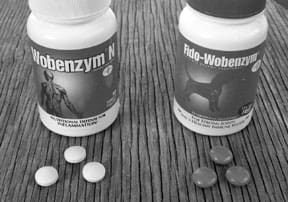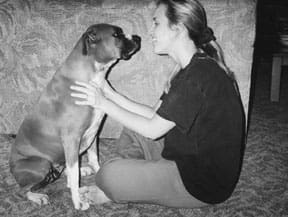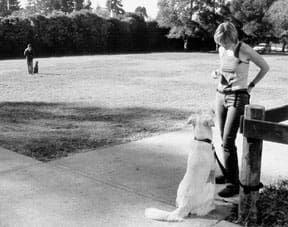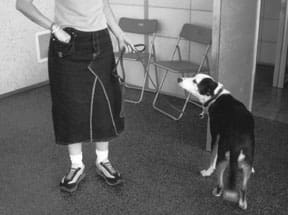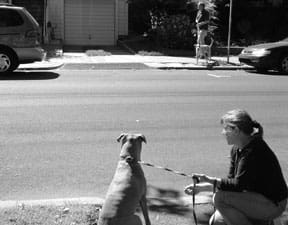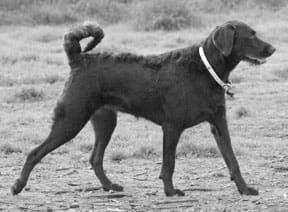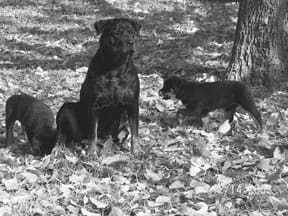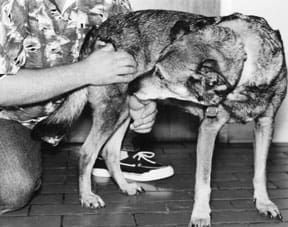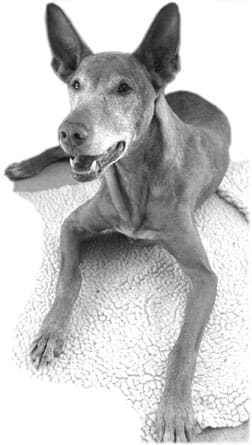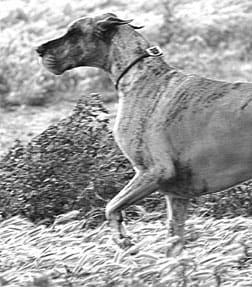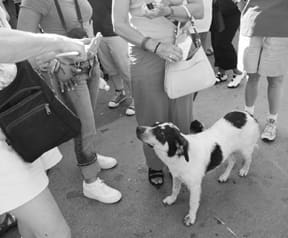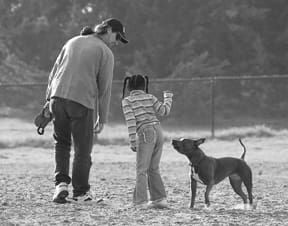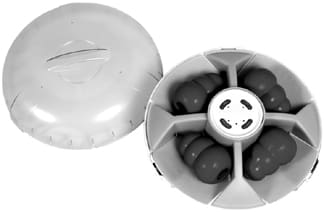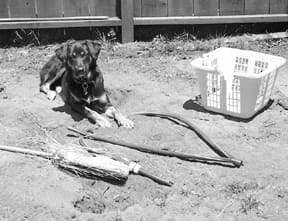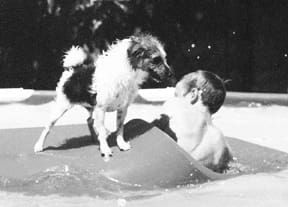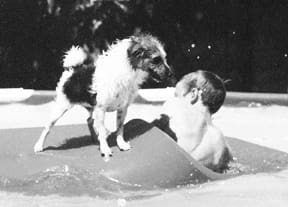By Pat Miller
Animal care professionals are fond of saying, “All dogs will bite, given the right (wrong) circumstances.” If that’s the case, how have I managed to suffer only two punctures in a 30-plus-year career working with dogs? Partly through reading and responding to canine body language well enough to avoid provoking an attack (see “How to Save Yourself,” September 2005). Partly, I’m sure, through luck. But largely, I suspect, because many dogs possess a wonderful quality known as “bite inhibition.”
Unconscious control
Bite inhibition is the ability of a dog to control the force of his bite. Without it, even a playful grab at your sleeve when you are wrestling with your dog or a quick snap of shocked self-defense (when you accidently step on his tail, for example) can result in a serious or painful puncture. In contrast, a dog in those same circumstances who has well-developed bite inhibition can grab your wrist and even gently shake it, or bite at the ankle of the foot that is planted on his tail –without leaving a mark or causing you more than a moment’s minor discomfort.
Canine behaviorists theorize that dogs have evolved to normally develop bite inhibition for good reason. In canine society, dogs normally use escalation of force effectively to get their messages across without inflicting grievous injury upon each other. This is important from a survival standpoint; if pack members consistently punctured each others’ skins over trivial issues, they’d risk their own injury and debilitation, even death, as well as that of the pack mates they depend upon for mutual protection, food gathering, and survival. Even when encountering canines from an “alien” pack, the less actual physical engagement, the better the chances of survival for all concerned.
Fortunately for humans, this bite inhibition often transfers to us, as members of our canines’ social groups.
How to get it
Bite inhibition is clearly a desirable thing. So how do you get it? Or more correctly, how does your dog get it? It’s not something you’ll find on the shelf of your local pet supply store!
Bite inhibition has both genetic and environmental components. That is, a dog can inherit the potential to use gentle bite pressure from parents who are also genetically programmed to mouth softly, and he can also learn to bite softly. Of course, the more strongly a desirable behavior trait is encoded in the genes, the easier it is to nurture appropriate behaviors. If your pup lacks good genes for bite inhibition, he’ll need lots of environmental influence – the sooner, the better.
Genetics of bite inhibition is one of the very important reasons to meet a pup’s parents, if possible, when you purchase from a breeder. While sometimes one or both parents simply aren’t available for legitimate reasons, if the breeder declines because either of the parents aren’t friendly, have bitten in the past, or cautions you to be careful when interacting with them, you may not want to risk purchasing a puppy from those lines. Make it a point to specifically ask if either parent has ever bitten, and if so, the severity of the bite, and how the breeder would characterize both dogs’ levels of bite inhibition. If she’s not willing to discuss the topic, doesn’t understand the question, or seems not to be forthcoming with information, make your puppy-purchase decision accordingly.
If you’re adopting from a shelter, Mom and Dad aren’t likely to be around. When you can’t meet parents, your personal observations during puppy selection – always important anyway – become even more critical. Most puppies will engage in some degree of mouthing – it’s how they explore their world. However, if you play with a number of puppies, you’ll discover that some mouth your hands gently, others will repeatedly bite hard enough with their wickedly sharp baby teeth to cause pain, and still others will even draw blood.
Those who consistently mouth gently have a healthy degree of innate bite inhibition and/or have learned their lessons well from Momdog and siblings who let them know when they bite too hard. Those who cause pain or draw blood need more lessons. There’s a good chance they can still turn into great dogs – and it will take more input on your part to teach them to be gentle with their teeth. The older a pup is, the more effort it will take to install bite inhibition, and the greater the likelihood that you’ll be less successful.
One of the reasons it’s such a tragedy to remove a pup from his litter too soon is that he’ll miss those all-important bite-inhibition lessons from Momdog and sibs. This is also one of the big drawbacks of adopting a singleton – a pup with no littermates. I strongly recommend you wait to take your new pup home until he’s at least seven weeks, preferably eight, regardless of how eager the breeder is to give him up. Your own bite inhibition lessons can never be as effective with your pup as those from his own kin. No matter how hard we try, we just can’t speak dog as well as dogs can.
Don’t punish!
In past times, and unfortunately sometimes still today, dog owners were counseled to use aversives to try to teach bite inhibition. If a puppy gnawed on your hands, some trainers suggested holding his muzzle closed as punishment, “cuffing” him under the chin with an open palm, or worse, shoving a fist down the pup’s throat. In a word… “Don’t!”
Not only are these methods abusive and have the potential to teach your pup to fear your hands, they can also trigger aggressive responses from assertive or fearfully defensive pups. If they do succeed in putting a stop to the mouthing, you may have taught the pup that his only options are to “Not Bite” or to “Bite Really Hard” rather than the third important “If You Must Bite, Bite Gently” option.
Remember, all dogs bite, given the right (wrong) set of circumstances. With enough provocation, even the most tolerant and gentle of dogs might be induced to put her mouth on human skin. With good bite inhibition, provocation is likely to result in a polite, “Please don’t do that” mouth-on-skin warning. Without it, the provoked dog is likely to cause serious damage when he puts his teeth on someone.
Things to do
The older a dog is when you start trying to teach bite inhibition, the greater the likelihood that, while you may succeed in teaching the dog to consciously use his mouth more gently, he will still fall back into hard biting during times of stress and arousal.
If you have a pup with naturally good bite inhibition, consider yourself blessed, and take steps to preserve this valuable natural resource. If not, start immediately to cultivate bite inhibition.
Play fetch games with your pup to direct his mouth toward appropriate toys to take some of the “wild puppy” edge off his bite. Be sure to give him plenty of exercise daily. A tired pup is a well-behaved pup. Consult your vet for guidance on how much exercise is appropriate for your pup.
Work with his bite inhibition while he’s in an ex-pen or on a tether so you can calmly escape his shark teeth. Begin petting him and playing gently. As long as he’s not causing pain, even if he’s putting his mouth on you with some pressure, continue playing.
If he bites and hurts you, calmly say “Ouch!” and walk away from him. Step outside the reach of the tether, or exit the ex-pen so he can’t follow you and continue to bite. The “Ouch!” isn’t intended to stop the biting; it only marks the behavior – tells him what he did that made you leave. This is negative punishment – his biting behavior makes a good thing – you – go away.
Wait 20-30 seconds to give him time to calm down, then go back to him and calmly resume playing. If he’s barking and aroused, wait to return until he settles. As long as he bites softly, continue playing. Any time his bite hurts, say “Ouch!” and leave.
If several repetitions don’t seem to reduce hard biting, give him longer time-outs to give him more time to settle.
Over time, as he learns to control his hardest biting, you can raise the bar – use the same methods to gradually shape a softer and softer mouth. When he’s no longer biting hard enough to hurt, use your “Ouch” technique for moderately hard bites, then medium ones, then finally, as he outgrows the puppy stage at 5-6 months, for any bites to skin at all.
If you must handle him when he’s being “bitey” – to groom, trim his nails, attach his leash – keep his teeth busy nibbling at treats you hold in one hand while you work with the other, or have a helper feed treats so you have both hands free to groom, trim, or leash.
This method of marking the inappropriate behavior and walking away from the pup imitates, to some degree, the behavior of Momdog and littermates when a pup bites too hard. If needle-sharp teeth clamp too hard on Momdog’s tender teats, she may stand up and exit the den. Pups learn to nurse gently to keep the milk bar open. Similarly, when pups play together, if one is too rough his playmate may “Yipe!” and decline to continue the game. Pup learns to inhibit his bite to keep the fun happening.
Some trainers teach owners to give a high-pitched “Yipe!” or “Ouch!” to mimic a littermate’s protestations. While this can work with some pups, others find it more arousing – perhaps because we don’t really know what we’re saying when we try to speak Dog.
I advise my clients to skip trying to imitate a puppy “Yipe!” and just use a calm “Ouch!” as a marker. If you do try the “Yipe!” once or twice and it works, great. If it doesn’t, don’t keep doing it! Simply replace it with a more composed marker.
More tips
Pups with poor bite inhibition can exhibit exceedingly frustrating behaviors. It’s easy to lose patience when those needle-sharp puppy canines sink into your skin. Remember that these “sharky” little guys usually love reactions; you’re playing into their paws when you lose your temper with them.
Use management solutions such as crates and baby gates so your pup doesn’t have access to you when you’re dressed up. Have treats and toys handy so you can toss them away from you and divert him when he’s approaching with mayhem on his mind. Do lots of work on the tether so you can repeatedly send the message that hard bites make the good stuff go away.
Young children should play with a shark-pup only under direct supervision, and only when the puppy is in a mellow mood. Most pups develop predictable cycles – if you know he’s calmest early to mid-afternoon, that’s when he can play with the kids. Controlled games only – no running around the backyard squealing while puppy tries to latch onto chubby, tender toddler legs!
If you’re doing positive training, with treats – and of course we hope you are – a hard-mouthed puppy can bring you to tears and leave your fingers bleeding as he clamps down on treats. It’s reassuring to know it gets easier when they lose their sharp baby teeth at five to six months, but meanwhile you’re tempted to stop training, or at least stop using treats! Try these temporary solutions:
• Keep your treat hidden in your closed fist until you feel your pup’s mouth soften. Then open your hand and feed the treat from the palm of your hand like you would feed a horse. This teaches the pup he gets the treat when his mouth is soft, and prevents finger-shredding because he’s taking it from your palm.
• Use metal finger splints. Available over-the-counter at pharmacies, these handy gadgets protect your fingers and teach him to be soft because most dogs don’t like to bite on metal.
• Feed treats from a metal spoon. This keeps your fingers out of his mouth and teaches him to be gentle; few dogs like to bite metal.
• Toss treats on the floor instead of handfeeding. This is a temporary solution, as there are many times in training when it’s far preferable to feed from the hand than the floor. On occasion though, it can save your fingers – and your sanity.
It may take a while to see the positive results of your gradual bite-inhibition lessons, but it’s worth it. Lucy, our Cardigan Corgi came to us at five months of age with a pretty hard bite – you knew when she took a treat from your fingers! It took months, and a lot of patience, to get her bite to soften.
At first it seemed we made no progress at all. Then for several months she’d start to bite down, I’d say “Ouch!” and feel her pause and relax her mouth before taking the treat. Now, at age 18 months, she takes treats sweetly, leaving fingers behind, intact, without a reminder. That alone was worth the effort, and I pray that it translates to true bite inhibition and nothing more than a Level 2 bite should the occasion ever arise that she feels compelled to put her teeth on human skin in earnest.
Also With This Article
“What To Do When Your Dog Bites”
-Pat Miller, CPDT, is WDJ’s Training Editor. She is also author of The Power of Positive Dog Training, and Positive Perspectives: Love Your Dog, Train Your Dog. Miller lives in Fairplay, Maryland, site of her Peaceable Paws training center.




